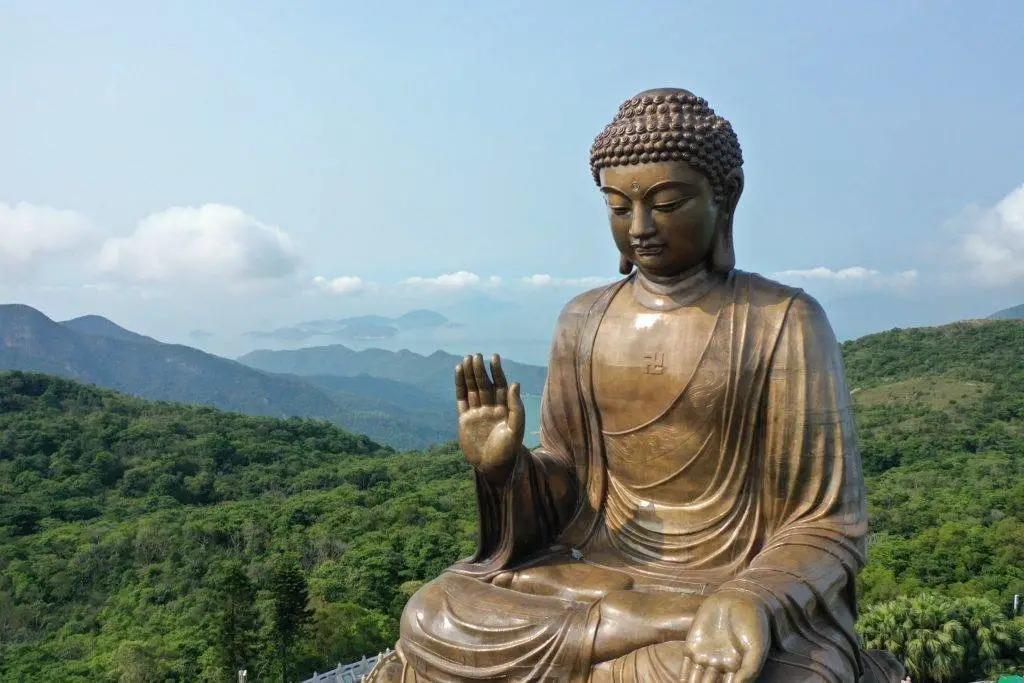Introduction to Tian Tan Buddha
Perched atop Lantau Island’s Muk Yue Shan peak, the Tian Tan Buddha, also known as the Big Buddha, stands as a monumental symbol of peace and harmony. This colossal bronze statue has become one of Hong Kong’s most recognizable landmarks since its completion in 1993.
Rising 34 meters (112 feet) high, the Tian Tan Buddha draws both pilgrims and tourists alike, offering a unique blend of spiritual significance and breathtaking views. Its commanding presence serves as a focal point for Buddhist devotion and a testament to Hong Kong’s rich cultural tapestry.

Historical Background and Construction
The Tian Tan Buddha was conceived as a project to enshrine a relic of Gautama Buddha and to promote Buddhism in Hong Kong. Construction began in 1990 and was completed in December 1993, funded by donations from devotees worldwide.
The statue’s design and location were carefully chosen for their symbolic significance:
| Aspect | Symbolism |
|---|---|
| Facing North | Watching over the Chinese people |
| Right Hand Raised | Delivering blessings |
| Left Hand Resting on Lap | Representing happiness |
| Pedestal Design | Resembles the Temple of Heaven in Beijing |
Crafted from 202 bronze pieces, the statue’s construction was a feat of engineering, requiring precise assembly at its lofty mountaintop site.

Physical Characteristics and Design
The Tian Tan Buddha’s impressive statistics include:
- Height: 34 meters (112 feet)
- Weight: Over 250 metric tons
- Base Diameter: 15 meters (49 feet)
The Buddha sits in the lotus position, embodying purity and enlightenment. Its serene facial expression conveys compassion and inner peace, inviting visitors to reflect and meditate.
Ascending the 268 steps to reach the statue is an integral part of the pilgrim’s journey, symbolizing the path to enlightenment. The surrounding platform offers panoramic views of Lantau Island and the South China Sea.

Cultural and Religious Significance
For Buddhists, the Tian Tan Buddha represents an important pilgrimage site, housing a relic of Gautama Buddha in its base. It stands in harmony with the adjacent Po Lin Monastery, creating a spiritual complex that attracts devotees from across Asia.
The site hosts various religious ceremonies throughout the year, including:
- Buddha’s Birthday celebrations
- Chinese New Year rituals
- Regular blessing ceremonies
Beyond its religious importance, the Tian Tan Buddha has become a cultural icon, significantly boosting tourism to Lantau Island and showcasing Hong Kong’s diverse heritage.

Visitor Experience and Attractions
At the base of the statue, visitors can explore the Hall of Universe, where the life of Buddha and various Buddhist scriptures are exhibited. The Grand Hall of Ten Thousand Buddhas, located beneath the statue, houses intricate carvings and artwork.
Six smaller bronze statues, known as “The Offering of the Six Devas,” encircle the main statue, each presenting offerings to the Buddha. These figures symbolize the Six Perfections of generosity, morality, patience, zeal, meditation, and wisdom.
Nearby Ngong Ping Village offers a taste of traditional Chinese culture with its themed walking streets, tea houses, and souvenir shops. The Ngong Ping 360 cable car provides a scenic 25-minute ride from Tung Chung, offering spectacular views of Lantau Island and the approaching Buddha statue.

Best Times to Visit and Photography Tips
The best time to visit is typically from October to December when the weather is mild and skies are clear. Early mornings offer the best lighting for photography, with fewer crowds.
For photographers:
- Use a wide-angle lens to capture the statue’s full magnitude
- Consider visiting during the golden hour for warm, dramatic lighting
- Include the surrounding mountains in your composition for scale
Special events like the annual Buddha’s Birthday celebration in May provide unique photo opportunities and cultural experiences.

Practical Information for Travelers
To reach Tian Tan Buddha:
- Take the MTR to Tung Chung Station
- Choose between the Ngong Ping 360 cable car or Bus 23 from Tung Chung
Entrance Fee: Free (museum inside the Buddha has a separate fee)
Opening Hours: 10:00 AM to 5:30 PM daily
Plan to spend at least 2-3 hours exploring the Buddha and surrounding area. Nearby attractions include:
- Wisdom Path
- Tai O Fishing Village
- Lantau Peak
When visiting, remember:
- Dress modestly out of respect for the religious site
- Be prepared for cooler temperatures at the mountaintop
- Bring water and snacks, as options may be limited
The Tian Tan Buddha is more than just a tourist attraction; it’s a place where spirituality, art, and nature converge. As you climb the steps towards this awe-inspiring figure, you’ll feel a sense of accomplishment mingled with reverence. The statue’s serene gaze, set against the backdrop of Lantau’s lush mountains, offers a moment of tranquility amidst Hong Kong’s bustling energy. Whether you’re seeking spiritual enlightenment or simply a breathtaking view, the Tian Tan Buddha provides an unforgettable experience that captures the essence of Hong Kong’s diverse cultural landscape.






